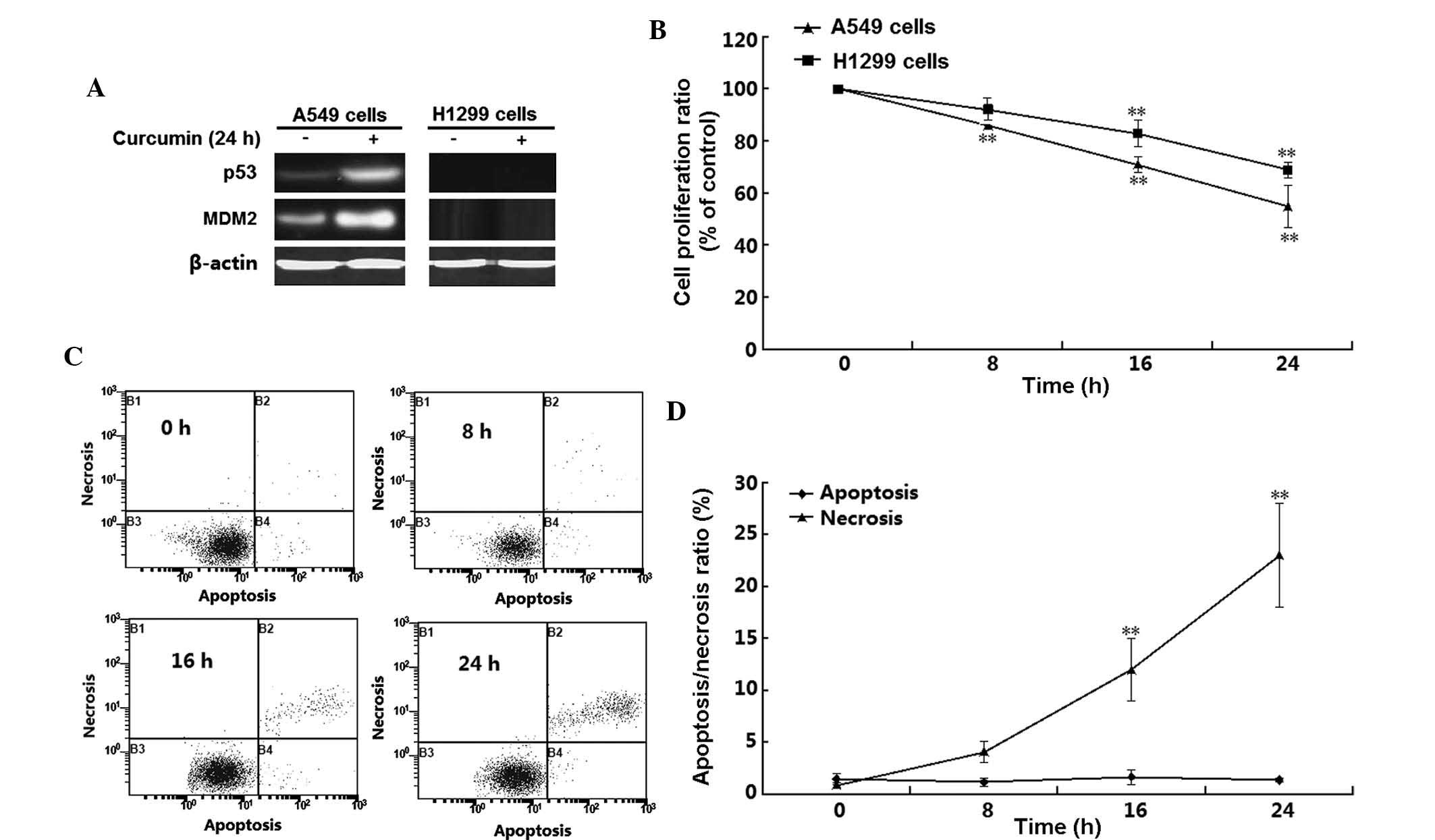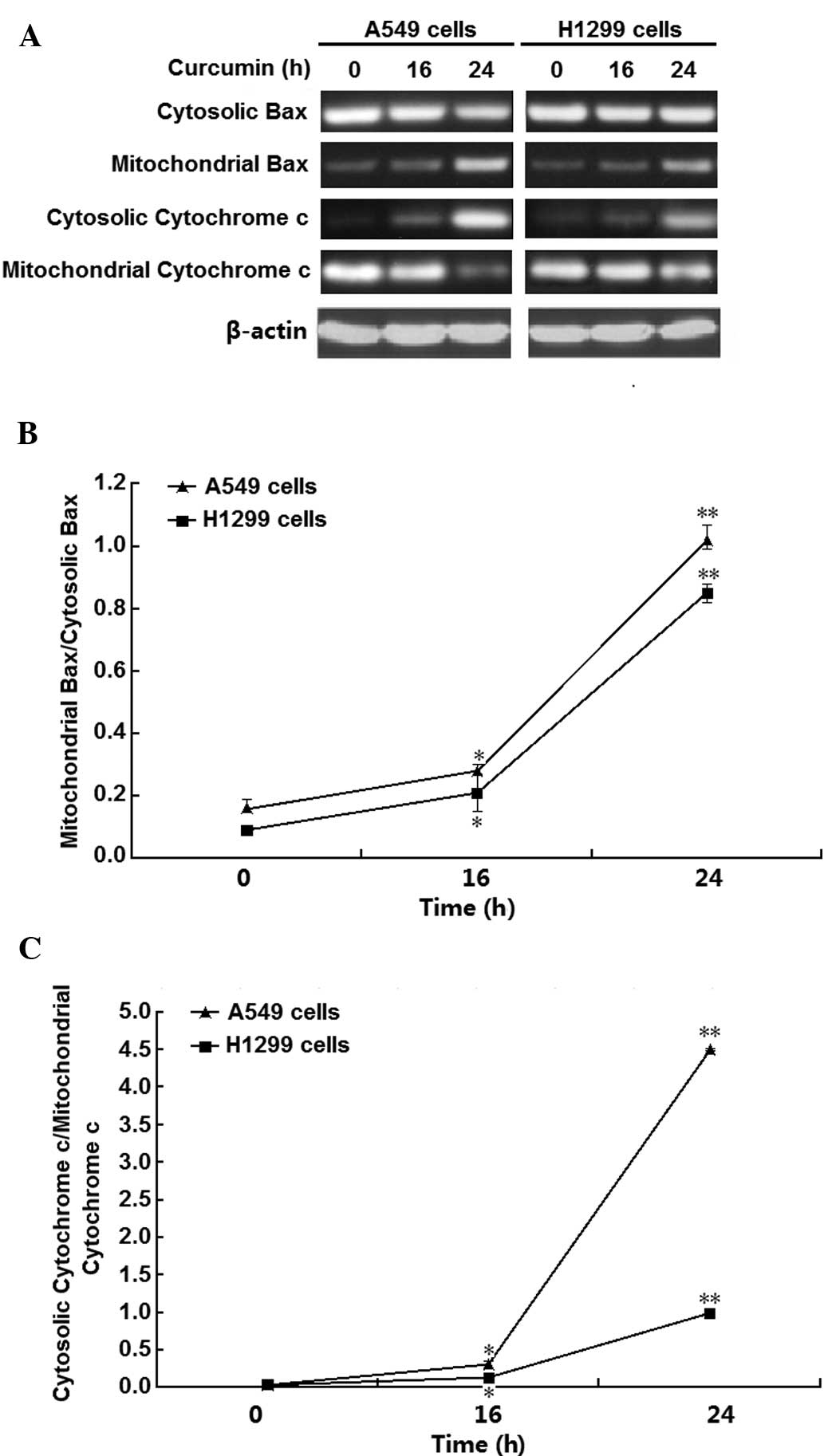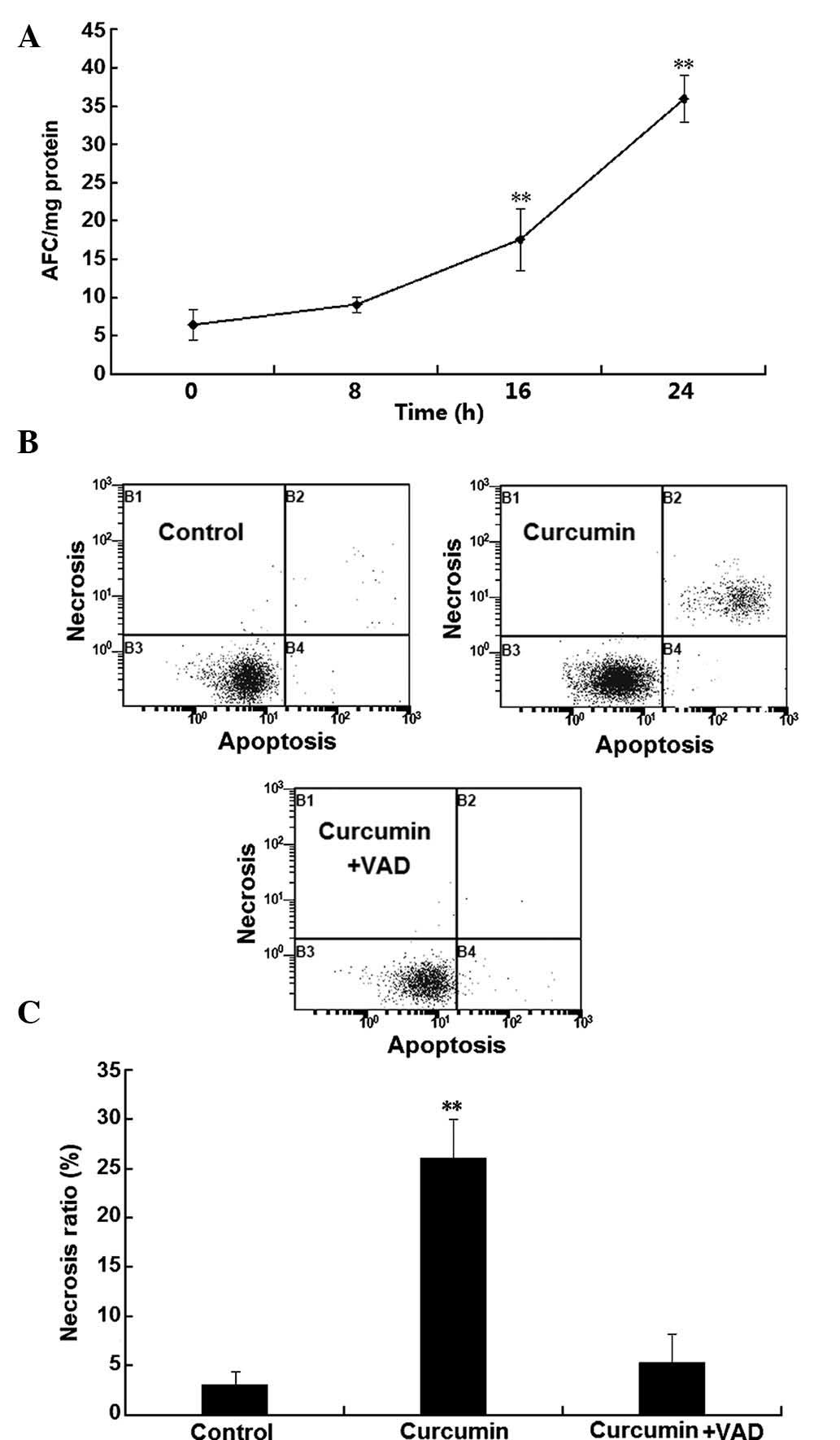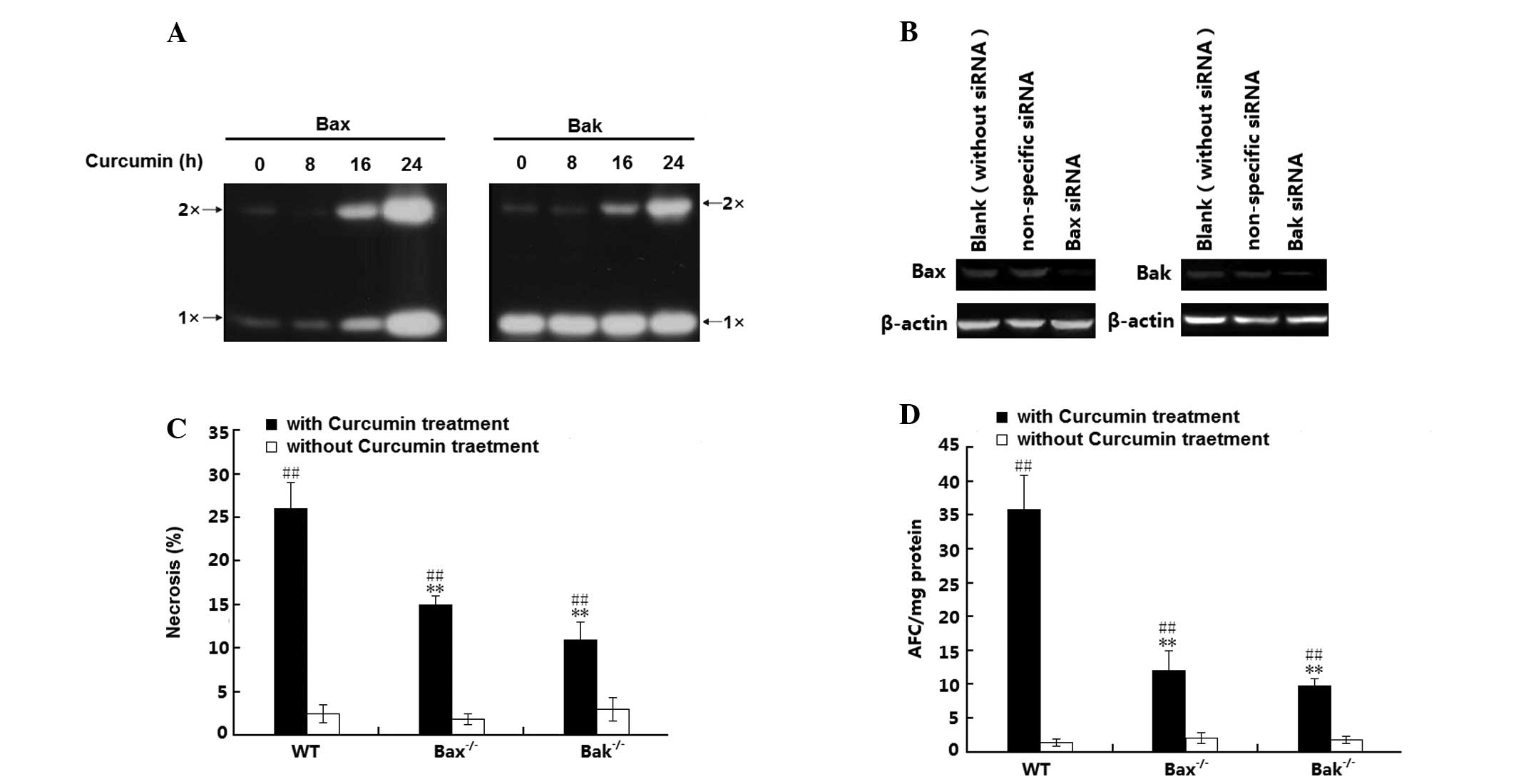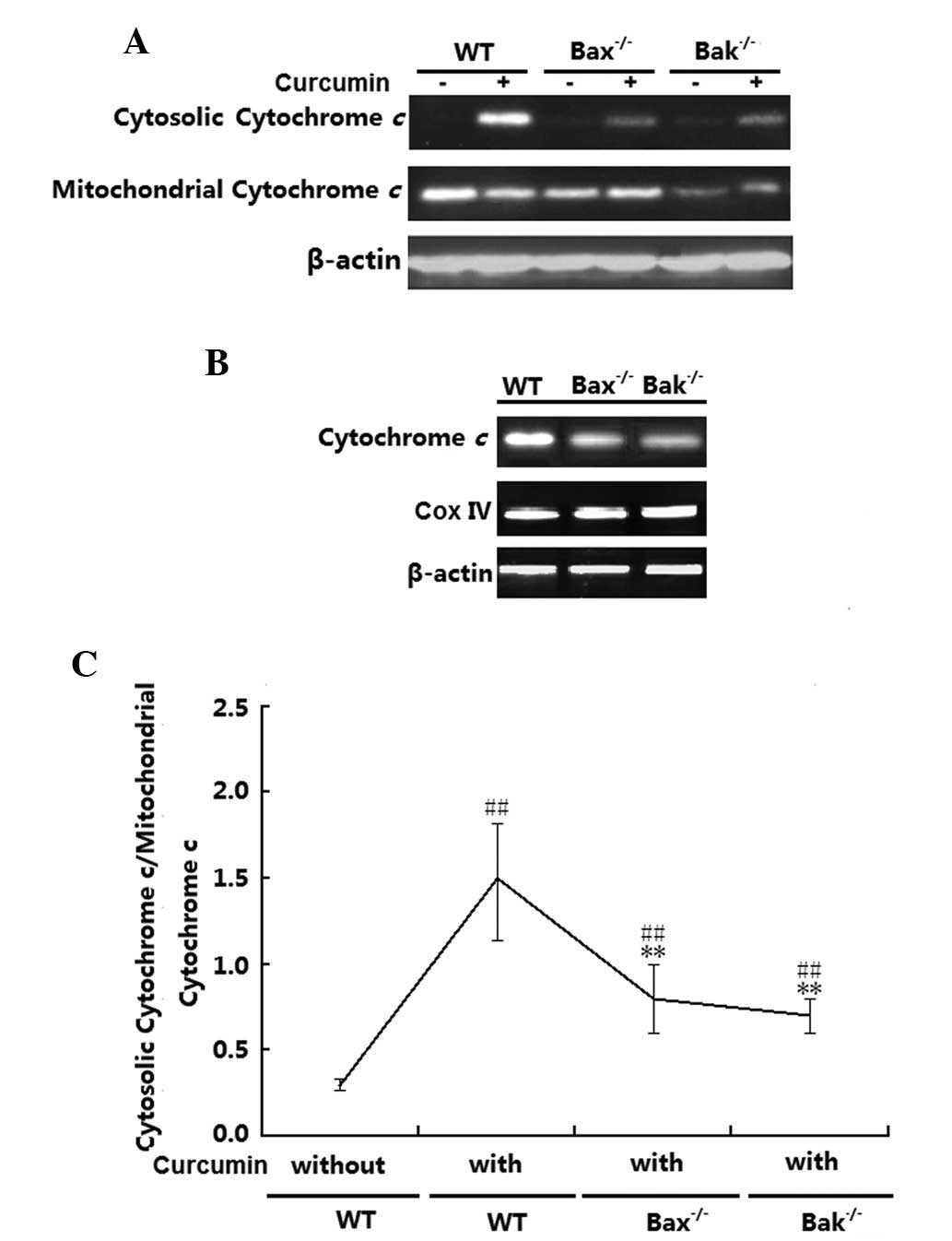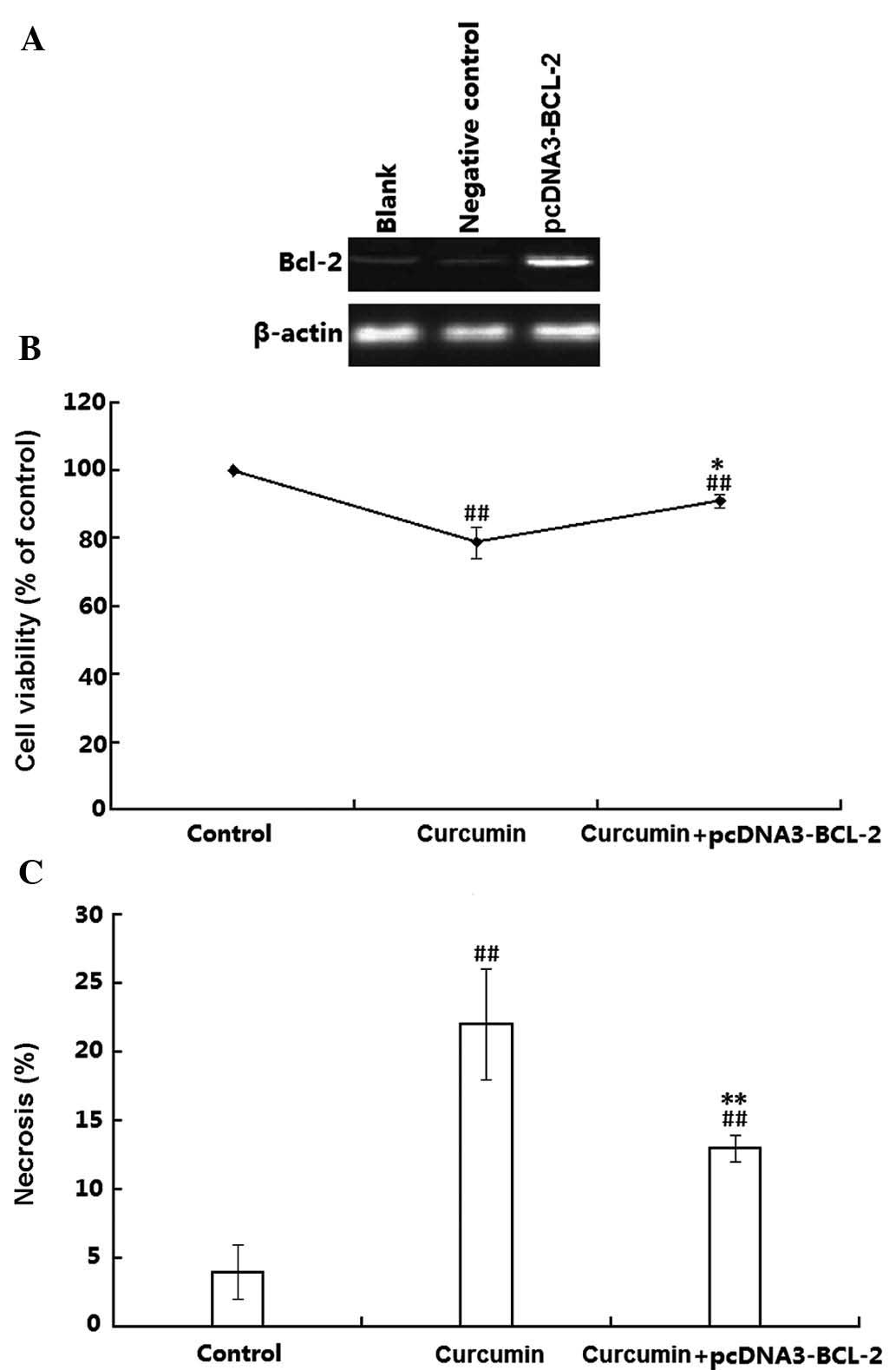Curcumin induces p53-independent necrosis in H1299 cells via a mitochondria-associated pathway
- Authors:
- Published online on: September 30, 2015 https://doi.org/10.3892/mmr.2015.4395
- Pages: 7806-7814
Abstract
Introduction
Curcumin, a polyphenol isolated from the rhizomes of the turmeric plant (Curcuma longa), is known to exhibit potent anti-neoplastic activity against a variety of human cancer types, including pancreatic, colon, ovarian and breast cancer, by modulating multiple signaling pathways (1–3). Curcumin has been reported to activate p53 signaling pathways, which upregulates the transcription of downstream genes, including B-cell lymphoma-2 (Bcl-2)-associated X protein (Bax) and Bcl-2 homologous antagonist killer (Bak), and downregulates pro-survival genes, including Bcl-2 and cyclin D1, to induce apoptosis in a variety of cancer cells (4,5). However, the tumor suppressor gene p53 is mutated or deficient in a large percentage of human malignancies, and whether or not curcumin has anti-cancer effects on these p53 deficient/mutant tumors has remained elusive.
Programmed cell death (PCD) has an important biological function in development and homeostasis in mammals. A common type of PCD is apoptosis, which may occur in multicellular organisms in response to endogenous or exogenous cellular injuries and molecular stimuli, including death ligands such as tumor necrosis factor-alpha (TNF-α), Fas ligand/CD95/apolipoprotein 1 and TNF-related apoptosis-inducing ligand, as well as DNA damaging agents, including benzo[a]pyrene, etoposide and 5-fluorouracil (6). In addition, induction of apoptosis is a key mechanism of action of cytotoxic anti-cancer drugs (7,8). Cell necrosis is an alternative form of PCD, which may, in contrast to apoptosis, proceed without activation of caspase family members. Programmed cell necrosis may participate in vital processes when caspase members are inhibited by pharmacological or genetic means, i.e. when interdigital webbing is removed during embryogenesis in apoptotic protease activating factor 1 (Apaf1)-deficient embryos (9,10). Similar to apoptosis, programmed cell necrosis can be activated by several key mediators, which have been identified through a genome-wide RNA interference screening; these include receptor-interacting protein kinase-1 (RIP1), RIP3, mitochondrial phosphoglycerate mutase family member 5 and mixed lineage kinase domain-like proteins (11). Cells may undergo programmed necrosis as an alternative mode of cell death when the caspase machinery fails or is inactivated (e.g. after viral infection or in apoptosis-resistant tumor cells) (12,13). Variable doses of stress may induce certain molecular events which are involved in apoptosis as well as necrosis signaling; therefore, cross-talk between the two cell death mechanisms exists (14,15). This suggests that necrosis is an intrinsic pathway, which may be equally important to apoptosis; however, the underlying molecular mechanisms of programmed necrosis have remained to be fully elucidated.
The tumor suppressor p53 has crucial roles in apoptosis, genomic stability and inhibition of angiogenesis (16). Upon activation, p53 can halt cell cycle progression by inhibiting G0/G1 phase transition, allowing for DNA repair factors to fix the DNA damage. If the extent of DNA damage proves to be irreparable, p53 initiates apoptosis through transcriptional activation of a series of target proteins, including MDM2 and the pro-apoptotic proteins Bax and Bak (17); or through transcriptional inhibition of pro-survival protein Bcl-xl and Bcl-2 (18). Previous studies have also demonstrated important roles for p53 in curcumin-induced apoptosis. For instance, curcumin can induce human HT-29 colon adenocarcinoma cell apoptosis by activating p53 and regulating apoptosis-associated protein expression (19). In another study, curcumin treatment was shown to improve the general health of patients with colorectal cancer via increasing p53 expression in tumor cells and to consequently accelerate tumor cell apoptosis (4). Loss of p53 function and the resulting evasion of apoptosis is the most common event during tumorigenesis in diverse types of human cancer, and the efficacy of apoptosis-inducing anti-cancer drugs is therefore decreased (20). To date, little is known regarding the efficacy of curcumin on p53-mutant/deficient cancer cells as well as the underlying mechanisms.
The present study sought to explore the p53-independent mechanisms of action of curcumin in lung cancer cells. Using a previous study as a guideline (21), curcumin at the concentration of 10 µM was selected for treating p53-proficient A549 cells and p53-deficient H1299 cells. The effects of curcumin on the proliferation, cytosolic and mitochondrial expression as well as homo-oligomerization of Bax and Bak, cytochrome c release and cell death in A549 and H1299 cells was assessed using an MTT assay, western blot analysis and flow cytometry. Furthermore, the caspase-dependency of the curcumin-induced cytotoxicity was tested using a fluorometric assay in the presence of caspase inhibitors. In addition, the effects of small interfering (si)RNA-mediated Bax and Bak knockdown as well as Bcl-2 overexpression on the necrotic death of H1299 cells were assessed. The present study suggested that curcumin induces necrosis in p53-deficient H1299 cells through mitochondrial-associated molecular pathways.
Materials and methods
Drugs
Curcumin (Sigma-Aldrich, St. Louis, MO, USA) was dissolved in dimethyl sulfoxide (DMSO; Sigma-Aldrich) at 10 mM as a stock solution. The dilutions of all of the reagents were freshly prepared prior to each experiment.
Cell lines
The p53-proficient lung cancer cell line A549 and the p53-deficient cell line H1299 were supplied by the Cell Bank of Type Culture Collection of the Chinese Academy of Science (Shanghai, China). A549 and H1299 cells were grown in Dulbecco's modified Eagle's medium (DMEM; Gibco, Thermo Fisher Scientific, Waltham, MA, USA) and in RPMI 1640 medium (Gibco) supplemented with 10% (v/v) fetal bovine serum (FBS; Gibco). The two cell lines were incubated at 37°C in a humidified atmosphere containing 5% CO2.
Reagents and antibodies
Rabbit polyclonal anti-p53 (cat. no. BS1278), rabbit polyclonal anti-BAX (cat. no. BS1725), rabbit polyclonal anti-BAK (cat. no. BS6477) and rabbit polyclonal MDM2 (cat. no. BS6818) primary antibodies were purchased from Bioworld Technology (St. Louis Park, MA, USA); primary antibody against Bcl-2 (cat. no. sc-492) was obtained from Santa Cruz Biotechnology (Dallas, TX, USA); rabbit polyclonal anti-cytochrome c (cat. no. BA0781) was supplied by Boster Bio-Engineering (Wuhan, China); rabbit monoclonal anti-cyclooxygenase (Cox)IV (cat. no. 18-7379) was purchased from Molecular Probes (Thermo Fisher Scientific); and all peroxidase-conjugated goat anti-rabbit secondary antibodies (cat. no. 00008-2) were obtained from Bioworld Technology. Chemical cross-linking agent bisma-leimidohexane (BMH), was supplied by Pierce Biotechnology, Inc. (Rockford, IL,USA). The carbobenzoxy-Val-Ala-Asp fluoromethyl ketone (Z-VAD-FMK), Asp-Glu-Val-Asp (DEVD)-7-amino-4-trifluoromethyl coumarin (AFC) were obtained from Selleck Chemicals (Houston, TX, USA); and propidium iodide (PI) and Annexin V fluorescein isothio-cyanate (FITC) double staining apoptosis detection kit was a product of Biotech (Hangzhou, China). The mitochondria/cytosol protein isolation kit was obtained from KeyGen (Nanjing, China) and Lipofectamine 2000 transfection reagent was from Invitrogen (Thermo Fisher Scientific).
Growth and cell proliferation analysis
A549 and H1299 cells were seeded in 96-well microplates and treated with 10 µM curcumin. The controls were treated with an equal volume of the vehicle (DMSO; final concentration, ≤0.1%). Following incubation, the supernatant in each well was replaced with 90 µl FBS-free medium and 10 µl MTT solution (final concentration, 5 mg/ml). The plates were then further incubated at 37°C for 4 h. Subsequently, the supernatant in each well was carefully aspirated and 150 µl DMSO was added to dissolve the MTT formazan. Following 15 min of incubation, the absorbance of each well was read using a microplate reader (model 680; Bio-Rad Laboratories, Inc., Hercules, CA, USA) at 570 nm wavelength. Three independent experiments using six parallel wells were performed.
Flow cytometric analysis
H1299 cells were seeded into six-well plates at density of 5×105 cells/well. The cells were treated with 10 µM curcumin. After incubation for 0, 8, 16 and 24 h, H1299 cells were collected and incubated with 5 µl Annexin V-FITC and 10 µl PI per 100 µl binding buffer in the dark for 20 min at room temperature. Finally, cell death mode analysis was performed using a FACSort flow cytometer (BD Biosciences, Franklin Lakes, NJ, USA). For each group, 10,000 events were collected and analyzed using Cell Quest software.
Measurement of caspase activity
H1299 cells were plated in six-well plates at a density of 8×105 cells/well and subse quently treated with 10 µM curcumin. After incubation for 0, 8, 16 and 24 h, the cells were collected and extracted with 1% Triton X-100 (Sigma-Aldrich). A total of 25 µg whole-cell lysate was subjected to an enzymatic reaction in the presence of 50 M DEVD-AFC at 37°C for 1 h. The fluorescent emission (excitation at 360 nm and emission at 530 nm) was measured. In addition, a standard curve was plotted for each measurement using free AFC. Using the standard curve, the fluorescence intensity of each enzymatic reaction was determined. The caspase activity was expressed in pmol/min/mg protein.
Bax/Bak siRNA transfection
To inhibit the expression of Bax or Bak in H1299 cells, gene silencing was performed using the Lipofectamine 2000 transfection reagent according to the manufacturer's instructions. The target siRNA and non-specific control siRNA sequences were as follows: Bak (beginning at nt 310), 5′-P-UGCCUACGAACUCUUCACCdTdT-3′ (sense) and 5′-P-GGUGAAGAGUUCGUAGGCAdTdT-3′ (anti-sense); Bax (beginning at nt 217), 5′-P-UAUGGAGCUGCAGAGGAUGdTdT-3′ (sense) and 5′-P-CAUCCUCUGCAGCUCCAUAdTdT-3′ (anti-sense); non-specific control siRNA, 5′-NNATTGTATGCGATCGCAGAC-3′. All of the above siRNA sequences were designed and synthesized by GenePharma (Shanghai, China). For transfection, H1299 cells were seeded into six-well plates at 3×105 cells per well. After incubation for 24 h, the cells were transfected with the specific Bax or Bak siRNA sequence using Lipfectamine 2000 trans-fection agent following the manufacturer's instructions. After 36 h of transfection, the cells were harvested for further study.
Western blot analysis
Western blotting was performed to determine the expression levels of apoptotic signaling molecules and their associated mitochondrial molecules in H1299 cells. Briefly, after incubation with 10 µM curcumin, 1×107 H1299 cells were harvested for protein extraction. Mitochondrial and mitochondria-free proteins were separated according to the instruction manual of the kit (KeyGen). The whole-cell lysate was extracted using radioimmunoprecipitation assay buffer (1 M Tris-HCl, 5 M NaCl, 1% Nonidet P-40, 1% sodium deoxycholate, 0.05% SDS and 1 mM phenylmethyl sulfonyl fluoride). Western blot analysis was then performed as previously described using SDS buffer (25 mM Tris, 192 mM glycine, 0.1% SDS) (22). The blots were subsequently incubated with the specific primary antibodies (1:400 dilution for all) at 4°C overnight, and with the corresponding IR dye-conjugated secondary antibodies (1:5,000 dilution for all) at room temperature for 1 h. Membranes were visualized using the Odyssey Infrared Imaging System and Odyssey v1.2 (LI-COR Biosciences, Lincoln, NE, USA). The relative densities of the protein bands were analyzed using Quantity One software (Bio-Rad Laboratories, Inc.).
Bax/Bak homo-oligomerization
The membrane-permeable cross-linking reagent BMH was used to analyze Bax/Bak oligomerization. Briefly, after incubation with indicated concentrations of curcumin, 1×107 of H1299 cells were collected for protein extraction. The mitochondrial-membrane fractions were separated by ultracentrifugation at 100,000 × g for 60 min at 2–8°C and re-suspended in 250 µl phosphate-buffered saline (PBS). The collected mitochondrial-membrane fraction was then incubated with 0.2 mM BMH in PBS for 1 h at room temperature with agitation at 12 × g/min. Finally, the above mixtures were dissolved by 4X SDS buffer, subjected to 12% SDS-PAGE and analyzed by immunoblot analysis using the corresponding primary antibodies.
Bcl-2 overexpression in H1299 cells
To establish Bcl-2-overexpressing H1299 cells, a Bcl-2 expression plasmid, pcDNA3-Bcl-2, was constructed (23). For transfection of the plasmid, H1299 cells were plated into six-well plates at 3×105 cells per well. The transfection procedure was performed as previously described with minimal revision (22).
Statistical analysis
Values are expressed as the mean ± standard deviation. Data were analyzed using a t-test. All statistical analyses were performed using SPSS, version 13.0 for Windows (SPSS Inc., Chicago, IL, USA). P<0.05 was considered to indicate a statistically significant difference between values.
Results
Curcumin inhibits A549 and H1299 cell proliferation
The effects of 10 µM curcumin on A549 and H1299 cell viability were assessed using an MTT assay at 8, 16 and 24 h post-treatment. The deficiency of p53 in H1299 cells was confirmed by western blot analysis of the expression of p53 and p53-target gene MDM2 (Fig. 1A). H1299 cells did not express p53 and MDM2 regardless of whether the cells were incubated with curcumin. By contrast, p53 as well as MDM2, were detected in A549 cells, and their expression was induced by curcumin treatment. These results confirmed the absence of p53 in H1299 cells, which were used in the subsequent experiments. The MTT assay showed that curcumin treatment time-dependently decreased the viability of the two cell lines (P<0.01) (Fig. 1B). Of note, the viability of A549 cells was affected by curcumin to a greater extant than that of H1299 cells; for instance, at the 16-h time-point, the proliferation rates of A549 and H1299 cells were 54 and 75%, respectively. To further determine the mode of H1299 cell death, flow cytometric analysis was performed following double staining with Annexin V-FITC and PI. As shown in Fig. 1C and D, a significant and time-dependent induction of H1299-cell necrosis was detected following 16–24 h of curcumin treatment (P<0.05). However, apoptosis was not significantly induced in H1299 cells by treatment with 10 µM curcumin for 8–24 h (P>0.05).
Curcumin-induced cell death is mitochondria-dependent
To investigate the underlying mechanisms of curcumin-induced H1299-cell necrosis, Bax and cytochrome c expression and distribution were examined. The results demonstrated that curcumin induced Bax translocation to mitochondria and cytochrome c release from the mitochondria in A549 and H1299 cells (Fig. 2A). The relative expression of Bax and cytochrome c in mitochondria and cytosol were then quantified by densito-metric analysis (Fig. 2B and C), showing that 10 µM curcumin significantly and time-dependently enhanced Bax translocation and cytochrome c release in the two cell lines (P<0.01 and P<0.05, respectively), particularly at the time-point of 24 h. These results suggested that mitochondria have important roles in curcumin-induced necrosis of A549 and H1299 cells.
Caspase family members are activated in curcumin-treated H1299 cells
To investigate the involvement of caspases in the programmed necrosis of H1299 cells, caspase activity was examined. As shown in Fig. 3A, a significant and time-dependent increase of caspase 3, 6 and 7 activity was observed following incubation with curcumin for 16–24 h (P<0.01). To confirm the involvement of caspases in the curcumin-induced death of H1299 cells, the effects of the classical caspase inhibitor z-VAD-FMK on H1299-cell necrosis were assessed using flow cytometry. As shown in Fig. 3B and C, after treatment with curcumin for 24 h, the number of necrotic cells was significantly increased, which was almost completely abrogated in the presence of the caspase inhibitor. This result suggested that curcumin-induced necrosis in H1299 cells was caspase-dependent.
Oligomerization of Bax and Bak is involved in curcumin-induced H1299 cell necrosis
The present study further investigated whether oligomerization between Bax and Bak is involved in curcumin-induced H1299-cell necrosis. For this, mitochondrial lysates were reacted with a chemical cross-linker to stabilize the oligomers for western blot analysis. As shown in Fig. 4A, almost no Bax oligomer was induced during 0–8 h of curcumin treatment; however, after incubation for 16–24 h, curcumin induced an increase of mitochondrial Bax levels and Bax oligomerization. Furthermore, although no change in mitochondrial Bak levels was detected, Bak oligomerization was also induced. To further elucidate effects of this sub-cellular distribution of Bax and Bak in curcumin-induced H1299 cell necrosis, the present study examined the cell death mode of wild-type (wt) H1299 cells as well as H1299 (Bax−/−) and H1299 (Bak−/−) cells, in which Bax and Bak had been silenced with specific siRNAs. The Bax and Bak knockdown efficiency was confirmed by western blot analysis (Fig. 4B). Following treatment with curcumin, a significant increase in the number of necrotic cells was observed in the H1299 (wt), H1299 (Bax−/−) and H1299 (Bak−/−) cells (P<0.01); of note, the amount of necrotic H1299 cells (wt) was significantly greater than that in the Bax- or Bak knockdown H1299 cell groups (Fig. 4C). In addition, these effects were confirmed by caspase activation analysis, revealing a significant increase of caspase activity in all of the three H1299-cell groups (P<0.01). In parallel to the necrotic rates, curcumin-increased caspase activity in (Bax−/−) and in (Bak−/−) H1299 cells was lower than that in H1299 cells (wt) (P<0.01). All of these results suggested that Bax and Bak as well as their oligomerization are involved in the curcumin-induced necrosis of H1299 cells.
Inhibition of Bax and Bak attenuates cytochrome c release in H1299 cells
Cytochrome c release levels in the H1299 (wt), H1299 (Bax−/−) and H1299 (Bak−/−) cells were examined. Fig. 5A and B shows that in the absence of curcumin, cytochrome c was mainly localized to the mitochondria irrespective of the cells' Bax or Bak status. After treatment with curcumin, cytochrome c release was significantly increased in the three groups (P<0.01); however, the release in the H1299 (Bax−/−) and (Bak−/−) H1299 cells was obviously lower than that in the H1299 (wt) cells (P<0.01). Total cytochrome c expression levels in the three cell lines were also detected by western blot analysis, revealing that cytochrome c expression levels in Bax- or Bak-deficient H1299 cells was lower than that in H1299 (wt) cells (Fig. 5C). However, no changes in the expression of mitochondrial CoxIV were observed in the three groups.
Overexpression of Bcl-2 attenuates necrosis and cytochrome c release in curcumin-treated H1299 cells
Finally, the present study examined the effects of plasmid-mediated Bcl-2 overexpression on the toxicity of curcumin on H1299 cells. Transfection efficiency was confirmed by western blot analysis, which demonstrated that the Bcl-2 protein levels in the transfected H1299 cells were obviously higher than those in the untransfected H1299 cells (Fig. 6A). The transfected H1299 cells were then treated with curcumin and the cell viability was assessed using an MTT assay. As shown in Fig. 6B, curcumin significantly decreased the cell viability in wt as well as in Bcl-2-overexpressing H1299 cells (P<0.01). However, the cell death rate in the Bcl-2 overexpressing cells was obviously lower than that in the wild-type H1299 cells (P<0.05). The effects of Bcl-2 on the cell viability were further proved by flow cytometry using double staining with Annexin V-FITC and PI. As shown in Fig. 6C, compared with the controls, the necrotic rate of wt H1299 cells was 22%, which was reduced to 13% in the Bcl-2 overexpressing H1299 cells. These results suggested that Bcl-2 attenuated curcumin-induced necrosis in H1299 cells.
Discussion
Curcumin, an active component of turmeric, which is used as a dietary supplement and a herbal medicine in numerous Asian countries, has been demonstrated to have potent anti-neoplastic effects on a variety of cancer cell types in vitro as well as chemo-preventive effects in murine carcinoma models (5). Curcumin inhibits the proliferation and induces apoptosis of various types of cancer cell (24,25). In agreement with previous studies, the present study revealed that after treatment for 16–24 h, 10 µM curcumin significantly decreased the viability of p53-proficient A549 cells and p53-deficient H1299 cells. In addition, the mode of cell death of H1299 cells was analyzed using flow cytometry, which demonstrated that the curcumin treatment resulted in necrosis, while only few apoptotic cells were present. Furthermore, the present study revealed that mitochondria were involved in the curcumin-induced H1299-cell necrosis. In addition, Bax and Bak were activated, which resulted in cytochrome c release caspase activation. Finally, the present study showed that Bax/Bak inhibition and Bcl-2 overexpression attenuated curcumin-induced H1299 cell necrosis. The present study indicated that the p53-independent mechanism of curcumin-induced necrosis of H1299 cells is associated with the mitochondria.
Apoptosis, an extensively studied and well-known type of PCD, is a highly regulated process in all multicellular organisms and is essential for embryonic development and adult tissue homeostasis. It has been recognized that deregulation of apoptosis contributes to the development of cancers (6). Conventional chemotherapeutic agents were developed based on the fact that the proliferation of tumor cells is upregulated. By targeting intracellular molecules including the DNA or microtubules, chemotherapeutics induce various degrees of damage or stress in rapidly dividing cells, leading to apoptosis (26). p53 has important roles in apoptosis-inducing cancer therapies through initiating the DNA damage response (27,28). p53 regulates DNA damage-induced apoptosis through a transcription-dependent pathway [involving MDM2 and p53-upregulated modulator of apoptosis (PUMA)], and/or a transcription-independent pathway (involving Bax, Bak and Bcl-2) (29,30). Of note, in the p53-deficient H1299 cells, Bax and Bak can be activated and form oligomers at mitochondrial sites, which may be involved in the regulation of the permeability of the mitochondrial outer membrane to induce permeability transition and cytochrome c release, which can in turn activate the caspase cascade (31). Results of previous studies and the present study indicated that curcumin exerts its cytotoxic effects via p53-dependent as well as p53-independent mitochondria-associated cell death mechanisms.
Bcl-2 family members are key regulators of mitochondria-dependent cell death. The molecular basis of the regulation of apoptosis through either pro-apoptotic members (Bax/Bak) or anti-apoptotic Bcl-2 is well known. Bcl-2 family proteins regulate mitochondrial apoptosis or/and necrosis through controlling the permeability of the mitochondrial membrane (32). However, with regard to the mechanism of action of curcumin on the p53-deficient H1299 cell line, it remains elusive how cell death signaling is initiated and how Bax and Bak are upregulated. Several potential pathways of p53-independent apoptosis have been previously reported. For instance, in doxorubicin-treated Saos-2 cells, overexpression of p73γ, a p53 family member, caused apoptosis and PUMA transactivation, which in turn activated mitochondrial translocation of Bax and cytochrome c release (33). Another study reported that in p53-mutant HT-29 colon cancer cells, quercetin induced apoptosis by decreasing the mitochondrial membrane potential, and increasing reactive oxygen species production and sestrin 2 expression through the adenosine monophosphate-activated protein kinase/p38 pathway (34). These previous studies, combined with the results of the present study, indicated that p53-dependent and p53-independent regulatory mechanisms may simultaneously contribute to the activation of Bax/Bak, which in turn trigger apoptosis; however, further studies are required to determine the exact underlying molecular mechanism.
Another noteworthy finding of the present study was the inter-dependence between Bax and Bak with regard to their activation in curcumin-treated H1299 cells. Bax and Bak were activated in H1299 cells (wt), while Bax and Bak translocation and oligomerization was partially inhibited in H1299 (Bak−/−) and H1299 (Bax−/−) cells. Furthermore, the anti-apoptotic protein Bcl-2 was shown to suppress curcumin-induced H1299 cell necrosis through abrogating the Bax - Bak interaction and inhibiting cytochrome c release. It remains elusive whether this Bax - Bak inter-dependence is linked to their function of permeabilizing the outer mitochondrial membrane. Previous studies suggested several possibilities; for instance, Bax and Bak contain a hydrophobic BH3 domain, which only becomes available for binding during activation to facilitate hetero- and homo-oligomerization (35,36). Furthermore, TNF-α-induced mitochondrial cytochrome c release and apoptosis of HeLa cells was associated with simultaneous homo-oligomerization and hetero-oligomerization of Bax/Bak (37). The present study indicated that Bax and Bak may function cooperatively and interdependently to permeabilize the outer mitochondrial membrane, resulting in the release of cytochrome c and activation of the caspase cascade.
Two pathways have been confirmed to be involved in apoptosis induction, including death receptor-dependent extrinsic and mitochondria-dependent intrinsic pathways (17,38). The intrinsic apoptotic pathway mediated by mitochondria is mainly triggered by the collapse of the mitochondrial membrane potential (39). The collapse prompts the release of pro-apoptotic cytochrome c into the cytoplasm, which has been proposed as a 'point of no return' in the mitochondrial pathway (40,41). Once mitochondria sense the cell death stimuli, cytochrome c is released into the cytosol, where it binds to Apaf-1 and caspase-9 to form a large complex termed the apoptosome, which in turn initiates the activation of downstream caspases 3, -6 and -7, as well as other apoptotic effectors; therefore, activation of the caspase-cascade system is the key event of mitochondria-dependent apoptosis (42,43). In addition, several previous studies suggested that the execution of necrotic cell death is caspase-independent (12,44). However, in the curcumin-treated H1299 cell model used in the present study, caspase activation was induced simultaneously with the appearance of cell necrosis. These results strongly indicated that apoptosis and necrosis may share common features, such as caspase activation.
In conclusion, the results of the present study revealed that curcumin exerts cytotoxic effects by inducing necrosis in the p53-deficient H1299 cell line through a mitochondria-associated pathway. The p53-independent mechanism was shown to include Bax/Bak translocation to mitochondria, where they permeabilized the outer mitochondrial membrane to trigger a cell death cascade. These results supported the potential of curcumin as a promising agent for the treatment of p53-defi-cient lung cancers.
Acknowledgments
The present study was supported by grants from the Science Technology Study of Hubei Department of Education Foundation (grant no. Q20141677).
Abbreviations:
|
DMSO |
dimethyl sulfoxide |
|
Bcl-2 |
B-cell lymphoma 2 |
|
BAX |
Bcl-2-associated X protein |
|
Bak |
Bcl-2 homologous antagonist killer |
References
|
O'Sullivan-Coyne G, O'Sullivan GC, O'Donovan TR, Piwocka K and McKenna SL: Curcumin induces apoptosis-independent death in oesophageal cancer cells. Br J Cancer. 101:1585–1595. 2009. View Article : Google Scholar : PubMed/NCBI | |
|
Friedman L, Lin L, Ball S, Bekaii-Saab T, Fuchs J, Li PK, Li C and Lin J: Curcumin analogues exhibit enhanced growth suppressive activity in human pancreatic cancer cells. Anticancer Drugs. 20:444–449. 2009. View Article : Google Scholar : PubMed/NCBI | |
|
Steward WP and Gescher AJ: Curcumin in cancer management: Recent results of analogue design and clinical studies and desirable future research. Mol Nutr Food Res. 52:1005–1009. 2008. View Article : Google Scholar : PubMed/NCBI | |
|
Shehzad A, Lee J, Huh TL and Lee YS: Curcumin induces apoptosis in human colorectal carcinoma (HCT-15) cells by regulating expression of Prp4 and p53. Mol Cells. 35:526–532. 2013. View Article : Google Scholar : PubMed/NCBI | |
|
Choudhuri T, Pal S, Agwarwal ML, Das T and Sa G: Curcumin induces apoptosis in human breast cancer cells through p53-dependent Bax induction. FEBS Lett. 512:334–340. 2002. View Article : Google Scholar : PubMed/NCBI | |
|
Alenzi FQ, Wyse RK and Altamimi WG: Apoptosis as a tool for therapeutic agents in haematological diseases. Expert Opin Biol Ther. 4:407–420. 2004. View Article : Google Scholar : PubMed/NCBI | |
|
Huang S, Shao K, Liu Y, Kuang Y, Li J, An S, Guo Y, Ma H and Jiang C: Tumor-targeting and microenvironment-responsive smart nanoparticles for combination therapy of antiangiogenesis and apoptosis. ACS Nano. 7:2860–2871. 2013. View Article : Google Scholar : PubMed/NCBI | |
|
Griffith TS: Induction of tumor cell apoptosis by TRAIL gene therapy. Methods Mol Biol. 542:315–334. 2009. View Article : Google Scholar : PubMed/NCBI | |
|
Sosna J, Voigt S, Mathieu S, Lange A, Thon L, Davarnia P, Herdegen T, Linkermann A, Rittger A, Chan FK, et al: TNF-induced necroptosis and PARP-1-mediated necrosis represent distinct routes to programmed necrotic cell death. Cell Mol Life Sci. 71:331–348. 2014. View Article : Google Scholar : | |
|
Proskuryakov SY, Gabai VL and Konoplyannikov AG: Necrosis is an active and controlled form of programmed cell death. Biochemistry (Mosc). 67:387–408. 2002. View Article : Google Scholar | |
|
Vandenabeele P, W Declercq F, Van Herreweghe, et al: The role of the kinases RIP1 and RIP3 in TNF-induced necrosis. Sci Signal. 2010.115:re4 | |
|
Baritaud M, Boujrad H, Lorenzo HK, Krantic S and Susin SA: Histone H2AX: The missing link in AIF-mediated caspase-independent programmed necrosis. Cell Cycle. 9:3166–3173. 2010. View Article : Google Scholar : PubMed/NCBI | |
|
Iwasaki R, Ito K, Ishida T, Hamanoue M, Adachi S, Watanabe T and Sato Y: Catechin, green tea component, causes caspase-independent necrosis-like cell death in chronic myelogenous leukemia. Cancer Sci. 100:349–356. 2009. View Article : Google Scholar : PubMed/NCBI | |
|
Nicotera P and Melino G: Regulation of the apoptosis-necrosis switch. Oncogene. 23:2757–2765. 2004. View Article : Google Scholar : PubMed/NCBI | |
|
Lin X, Sun T, Cai M and Shen P: Cell-death-mode switch from necrosis to apoptosis in hydrogen peroxide treated macrophages. Sci China Life Sci. 53:1196–1203. 2010. View Article : Google Scholar : PubMed/NCBI | |
|
Bergeron L, Perez GI, Macdonald G, et al: Defects in regulation of apoptosis in caspase-2-deficient mice. Genes Dev. 12:1304–1314. 1998. View Article : Google Scholar : PubMed/NCBI | |
|
Hosseinimehr SJ, Azadbakht M, Tanha M, Mahmodzadeh A and Mohammadifar S: Protective effect of hawthorn extract against genotoxicity induced by methyl methanesulfonate in human lymphocytes. Toxicol Ind Health. 27:363–369. 2010. View Article : Google Scholar : PubMed/NCBI | |
|
Kosmider B, Wojcik I, Osiecka R, Bartkowiak J, Zyner E, Ochocki J and Liberski P: Enhanced P53 and BAX gene expression and apoptosis in A549 cells by cis-Pt(II) complex of 3-aminoflavone in comparison with cis-DDP. Invest New Drugs. 23:287–297. 2005. View Article : Google Scholar : PubMed/NCBI | |
|
Song G, Mao YB, Cai QF, Yao LM, Ouyang GL and Bao SD: Curcumin induces human HT-29 colon adenocarcinoma cell apoptosis by activating p53 and regulating apoptosis-related protein expression. Braz J Med Biol Res. 38:1791–1798. 2005. View Article : Google Scholar : PubMed/NCBI | |
|
Yu JL, Rak JW, Coomber BL, et al: Effect of p53 status on tumor response to antiangiogenic therapy. Science. 295:1526–1528. 2002. View Article : Google Scholar : PubMed/NCBI | |
|
Tian F, Song M, Xu PR, et al: Curcumin promotes apoptosis of esophageal squamous carcinoma cell lines through inhibition of NF-kappaB signaling pathway. Ai Zheng. 27:566–570. 2008.In Chinese. PubMed/NCBI | |
|
Zhang W, Liu N, Wang X, et al: Benzo(a)pyrene-7,8-diol-9,10-epoxide induced p53-independent necrosis via the mitochondria-associated pathway involving Bax and Bak activation. Hum Exp Toxicol. 34:179–190. 2015. View Article : Google Scholar | |
|
Guo BC and Xu YH: Bcl-2 over-expression and activation of protein kinase C suppress the trail-induced apoptosis in Jurkat T cells. Cell Res. 11:101–106. 2001. View Article : Google Scholar : PubMed/NCBI | |
|
Bar-Sela G, Epelbaum R and Schaffer M: Curcumin as an anti-cancer agent: Review of the gap between basic and clinical applications. Curr Med Chem. 17:190–197. 2010. View Article : Google Scholar : PubMed/NCBI | |
|
Tian C, Xing G, Xie P, et al: KRAB-type zinc-finger protein Apak specifically regulates p53-dependent apoptosis. Nat Cell Biol. 11:580–591. 2009. View Article : Google Scholar : PubMed/NCBI | |
|
Blankenberg FG: Apoptosis imaging: Anti-cancer agents in medicinal chemistry. Anticancer Agents Med Chem. 9:944–951. 2009. View Article : Google Scholar | |
|
Meulmeester E and Jochemsen AG: p53: A guide to apoptosis. Curr Cancer Drug Targets. 8:87–97. 2008. View Article : Google Scholar : PubMed/NCBI | |
|
Xu Y: Regulation of p53 responses by post-translational modifications. Cell Death Differ. 10:400–403. 2003. View Article : Google Scholar : PubMed/NCBI | |
|
Leibowitz BJ, Qiu W, Liu H, Cheng T, Zhang L and Yu J: Uncoupling p53 functions in radiation-induced intestinal damage via PUMA and p21. Mol Cancer Res. 9:616–625. 2011. View Article : Google Scholar : PubMed/NCBI | |
|
Thakur VS, Ruhul Amin AR, Paul RK, Gupta K, Hastak K, Agarwal MK, Jackson MW, Wald DN, Mukhtar H and Agarwal ML: p53-Dependent p21-mediated growth arrest pre-empts and protects HCT116 cells from PUMA-mediated apoptosis induced by EGCG. Cancer Lett. 296:225–232. 2010. View Article : Google Scholar : PubMed/NCBI | |
|
Morales-Cruz M, Figueroa CM, Gonzalez-Robles T, et al: Activation of caspase-dependent apoptosis by intracellular delivery of cytochrome c-based nanoparticles. J Nanobiotechnology. 12:332014. View Article : Google Scholar : PubMed/NCBI | |
|
Antignani A and Youle RJ: How do Bax and Bak lead to permeabilization of the outer mitochondrial membrane? Curr Opin Cell Biol. 18:685–689. 2006. View Article : Google Scholar : PubMed/NCBI | |
|
Holcakova J, Ceskova P, Hrstka R, Muller P, Dubska L, Coates PJ, Palecek E and Vojtesek B: The cell type-specific effect of TAp73 isoforms on the cell cycle and apoptosis. Cell Mol Biol Lett. 13:404–420. 2008. View Article : Google Scholar : PubMed/NCBI | |
|
Kim GT, Lee SH, Kim JI and Kim YM: Quercetin regulates the sestrin 2-AMPK-p38 MAPK signaling pathway and induces apoptosis by increasing the generation of intracellular ROS in a p53-independent manner. Int J Mol Med. 33:863–869. 2014.PubMed/NCBI | |
|
Kim H, Tu HC, Ren D, et al: Stepwise activation of BAX and BAK by tBID, BIM, and PUMA initiates mitochondrial apoptosis. Mol Cell. 36:487–499. 2009. View Article : Google Scholar : PubMed/NCBI | |
|
Antonsson B, Montessuit S, Lauper S, et al: Bax oligomerization is required for channel-forming activity in liposomes and to trigger cytochrome c release from mitochondria. Biochem J. 345(Pt 2): 271–278. 2000. View Article : Google Scholar : PubMed/NCBI | |
|
Sundararajan R, Cuconati A, Nelson D and White E: Tumor necrosis factor-alpha induces Bax-Bak interaction and apoptosis, which is inhibited by adenovirus E1B 19K. J Biol Chem. 276:45120–45127. 2001. View Article : Google Scholar : PubMed/NCBI | |
|
Wachter F, Grunert M, Blaj C, Weinstock DM, Jeremias I and Ehrhardt H: Impact of the p53 status of tumor cells on extrinsic and intrinsic apoptosis signaling. Cell Commun Signal. 11:272013. View Article : Google Scholar : PubMed/NCBI | |
|
Mehmeti I, Gurgul-Convey E, Lenzen S and Lortz S: Induction of the intrinsic apoptosis pathway in insulin-secreting cells is dependent on oxidative damage of mitochondria but independent of caspase-12 activation. Biochim Biophys Acta. 1813:1827–1835. 2011. View Article : Google Scholar : PubMed/NCBI | |
|
Buratta M, Castigli E, Sciaccaluga M, Pellegrino RM, Spinozzi F, Roberti R and Corazzi L: Loss of cardiolipin in palmitate-treated GL15 glioblastoma cells favors cytochrome c release from mitochondria leading to apoptosis. J Neurochem. 105:1019–1031. 2008. View Article : Google Scholar : PubMed/NCBI | |
|
Lee HJ, Lee HJ, Lee EO, Ko SG, Bae HS, Kim CH, Ahn KS, Lu J and Kim SH: Mitochondria-cytochrome C-caspase-9 cascade mediates isorhamnetin-induced apoptosis. Cancer Lett. 270:342–353. 2008. View Article : Google Scholar : PubMed/NCBI | |
|
Nakabayashi J and Sasaki A: A mathematical model for apoptosome assembly: The optimal cytochrome c/Apaf-1 ratio. J Theor Biol. 242:280–287. 2006. View Article : Google Scholar : PubMed/NCBI | |
|
Adrain C and Martin SJ: The mitochondrial apoptosome: A killer unleashed by the cytochrome seas. Trends Biochem Sci. 26:390–397. 2001. View Article : Google Scholar : PubMed/NCBI | |
|
Kihana T, Tsuda H, Teshima S, et al: High incidence of p53 gene mutation in human ovarian cancer and its association with nuclear accumulation of p53 protein and tumor DNA aneuploidy. Jpn J Cancer Res. 83:978–984. 1992. View Article : Google Scholar : PubMed/NCBI |



